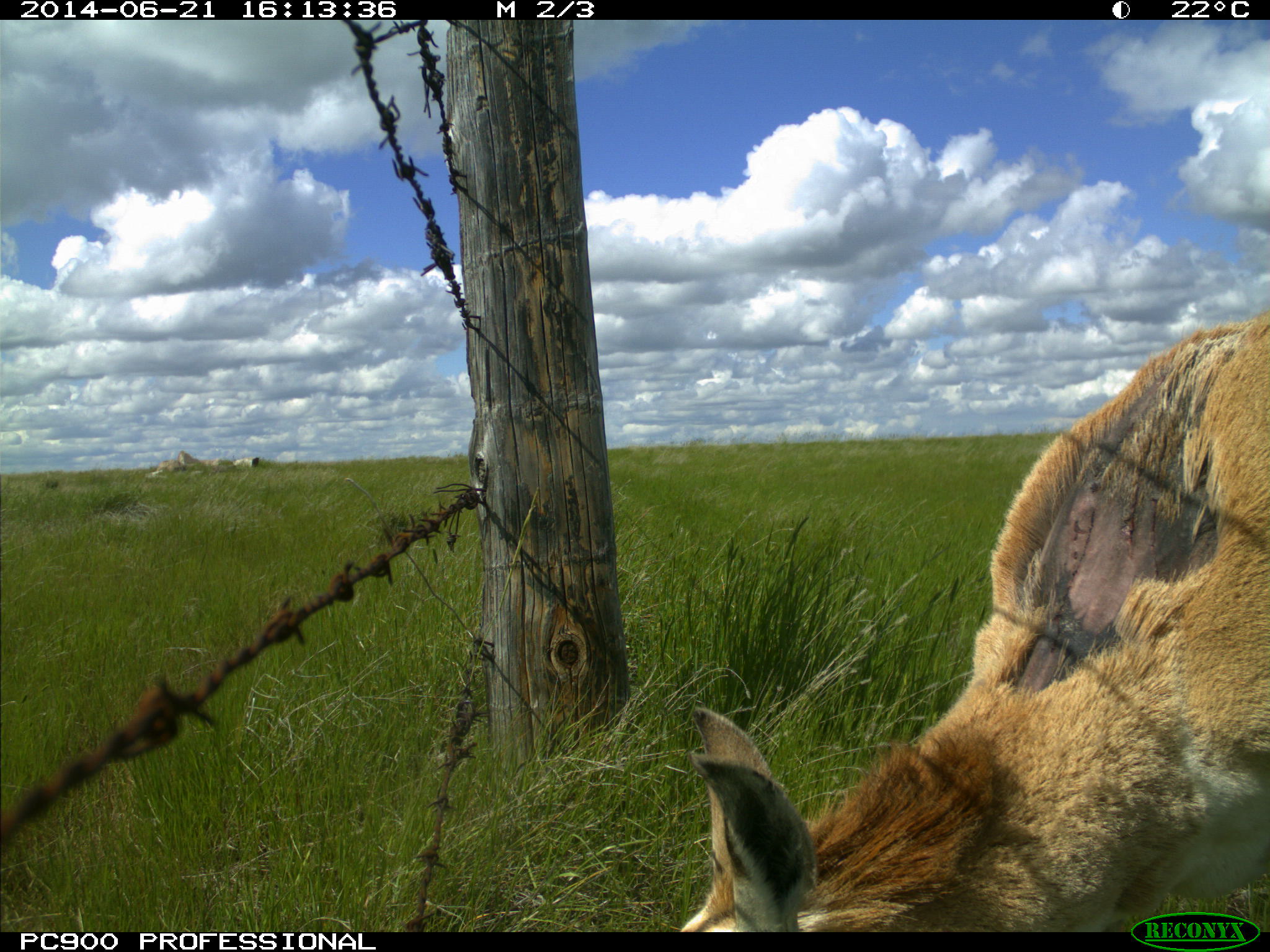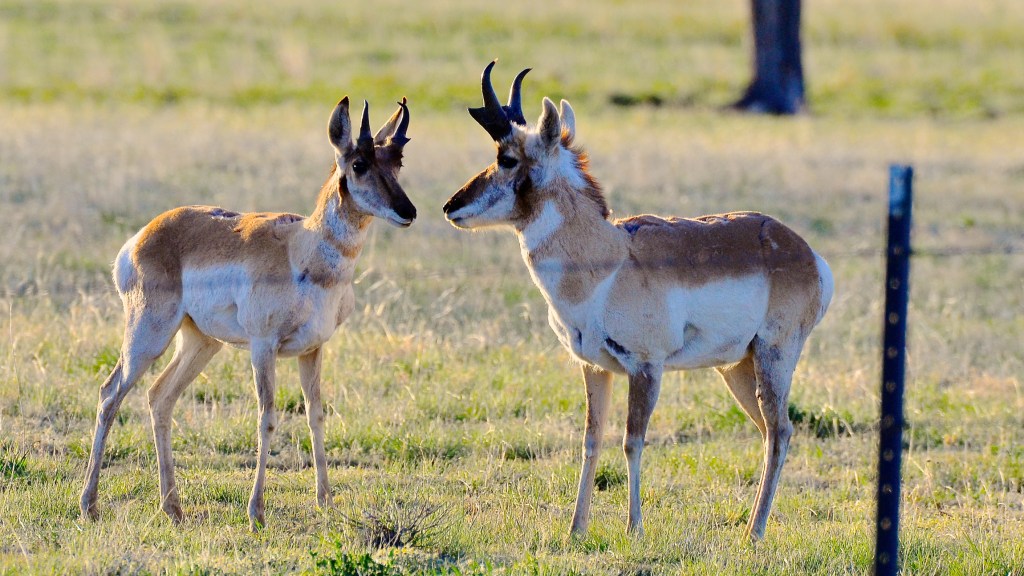Pronghorn may be the second fastest land mammal on Earth, but a simple fence can stop them in their tracks. Their speed has allowed them to roam the continent for millennia, surviving the age of the wooly mammoth and saber-toothed tiger, but it is geography and evolution that account for one notable shortcoming.
“People want to know why they don’t jump,” says University of Montana wildlife biologist Andrew Jakes. “Pronghorn are a highly adapted species to open landscapes. Although they have the ability to jump, they typically crawl under fencing since, for eons, they never had to jump over anything taller than sagebrush.”

In a Western landscape crisscrossed with thousands of miles of barbed-wire fencing, these migrating animals face a real dilemma.
The biggest problem is that the bottom wire of many fences is strung too low for pronghorn to crawl under safely. “Even when they can squeeze under, the barbed wire often scrapes off hide,” says Montana Grasslands Conservation Director Brian Martin. “That exposes the animals to infection and frostbite.”

Pronghorn are known to travel many extra miles searching for places to cross a fence during migration, burning up calories that will be vital to get them through the long northern winters.
That’s why Jakes, Martin and the staff of the Conservancy’s Matador Ranch joined with the Alberta Conservation Association to study the best ways to modify fences so that they allow pronghorn to pass through them safely, while keeping cattle inside.
The researchers studied three different modifications on the Matador Ranch in Montana and locations in Alberta. Each raised the bottom wire to a minimum of 18” off the ground – high enough for the pronghorn and young deer and elk to get under, but low enough to contain cattle. In one case, they replaced the lowest barbed wire with a smooth wire.

In the second they encased the lowest wire in plastic pipe – a so-called “goat bar.” Both those methods created a smooth bottom surface.

In the third, they lifted the lowest wire by clipping it to the one above with an inexpensive carabiner.

While all three methods created enough space to crawl under, both pronghorn and deer completely balked at the goat bar. That was an important discovery since the method has been a commonly recommended solution by wildlife agencies.
For many landowners, the carabiner method may be the way to go.
“Raising bottom fence wires with a clip can be a great first step in enhancing the passage for pronghorn, given how quickly it can be accomplished for a minimum cost,” says the Conservancy’s Martin.
The researchers also confirmed that pronghorn are creatures of habit. They tend to return to the same crossing points year after year, and they condition their young to do the same. That finding helps us make smart decisions about where to remove or modify fences or where to simply leave gates open during times of deep snow and critical migration periods.

With pronghorn seasonally migrating more than 200 miles each way between their summer grounds in Canada and their wintering grounds in Montana, eliminating obstacles to their movement can be a matter of life and death.
Of course, the best fence for wildlife is no fence at all, so in addition to modifying miles of fencing, the Conservancy and our partners are completely removing many more miles.




And “Thank You” to the ranchers / farmers that all helping with such a simple fix !!!!
Great! The carabiner is the choice of the animals [ regardless of what agencies or professionals believe works best 🙂 ]; and it’s the cheapest method.
So now let’s work on the government agencies enforcing / helping the farmers with the carabiner so that everyone can win.
Very interesting. Thanks.
I think the carabiner method is perfect. Its quick and easy and a huge help to migrating animals. Bravo to whoever thought up such a great idea. I hate barbed wire and remove old wire from abandoned pastures all the time when I am out hiking with my goats.
This is so wonderful to know. We cross through Montana every so often going to ND from WA and have greatly enjoyed seeing the pronghorns. You just taught me something about them! Thank you!
I feel the antelope are very important in the ecological cycle of our land in Converse county , Wyoming. Glad to see much thought given to protect migration.
the best method is to remove the fencing and let nature be natural to be one with the earth. We should strive to keep nature as natural as it should be for our wild animals that keep the earth moving in the right direction as nature intended…
I’ve always hated barbed wire. I’m glad there are steps being taken to remove some of it. animal get injured by it frequently. I lived in farm country most of my adult life, and I know many farmers and ranchers are environmental heroes. After all, seeing wildlife is one of the great pleasures of living in the country.
Seems like that would be an easy thing to do g
Thank you for your efforts on behalf of the pronghorn. Keep up your efforts to help us live with wildlife.
Many thanks go to the ranchers who gave a damn and helped an endangered species. God bless you from one environmentalist to another!
I found this totally fascinating and also made me so happy that there are caring people in this world. thank you for helping these amazing animals to survive, to continue on their treks and be safe.
That raising of the wires is good, but no fences is a better alternative to helping the wildlife.
These gorgeous animals have a hard enough life without humans putting more and more obstacles in their path/encroaching on their habitats. As far as I’m concerned this is the very least we owe them to do. We as humans need to do much, much more and with forethought. Our actions without forethought can have severe consequences as written above. At least humanity is taking a second look at its actions and the destruction it’s caused/causing and hopefully we will eventually reverse it.
Thank you so much for the good work you do! Learning what will be the easiest, cheapest solutions to common problems facing wildlife, means many more humans will join that effort, and far more animals will survive. I applaud your work and sure hope it is getting the press that it needs to reach the masses of humans that ultimately will make the difference. I would also like to suggest that everyone who enjoys the outdoors (and loves wildlife), whether it be hiking, mountain biking, fishing – you name it – pack a handful of these cheap carabiners when you head out… and be the change you’d like to see in the world!